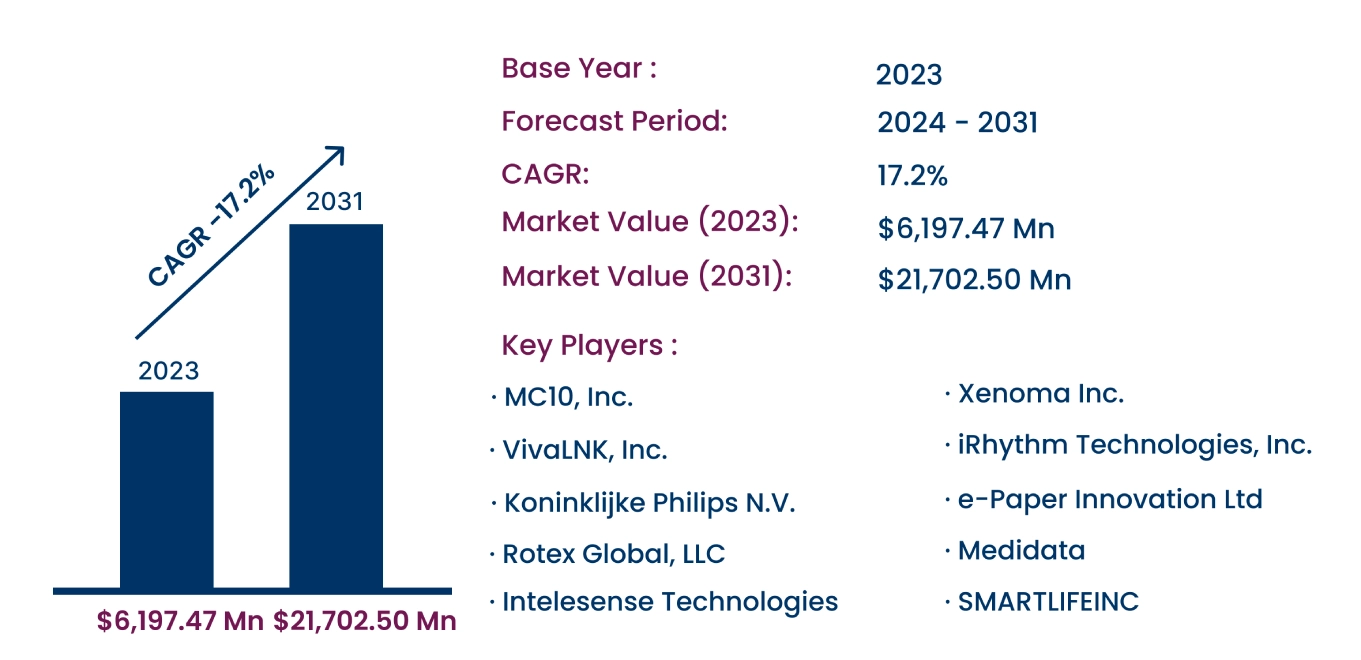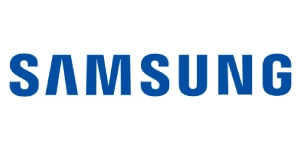Global Electronic Skin Market to Reach USD 21,702.50 Million by 2031 | CAGR of 17.2%
Category : Healthcare | Published Date : Oct 2024 | Type : Press Release
Electronic Skin Market Scope & Overview:
In the newly published report, Consegic Business Intelligence states that the Electronic Skin Market was valued at USD 6,197.47 Million in 2023 and is projected to reach USD 21,702.50 Million by 2031, growing at a CAGR of 17.2% from 2024 to 2031. Electronic skin, or e-skin, is a flexible, wearable synthetic material designed to replicate the properties of human skin. It integrates various sensors to detect stimuli such as temperature, pressure, and motion, offering applications in healthcare, robotics, and human-computer interaction.
The report comprises the Electronic Skin Market Share, Size & Industry Analysis, By Product (Electronic Patches, Electronic Skin Suits), Component (Sensors, Stretchable Circuits, Photovoltaic Systems, Stretchable Conductors, Electroactive Polymers), Sensors (Tactile Sensors, Electrophysiological Sensors, Chemical Sensors, Others), Application (Drug Delivery Systems, Health Monitoring Systems, Cosmetics, Wearable Technology), and By Region (North America, Europe, Asia-Pacific, Latin America, Middle East & Africa), and Forecast, 2024-2031.
The report contains detailed information on Electronic Skin Market Trends, Opportunities, Value, Growth Rate, Segmentation, Geographical Coverage, Company Profile, In-depth Expert Analysis, Revenue Forecast, Competitive Landscape, Growth Factors, Restraints or Challenges, Environment & Regulatory Landscape, PESTLE Analysis, PORTER Analysis, Key Technology Landscape, Value Chain Analysis, and Cost Analysis.
Rising applications in healthcare and advancements in smart textiles drive market growth. Additionally, developments in fashion-related smart textiles present growth opportunities.
Segmental Analysis :
Based on product, the market is bifurcated into electronic patches and electronic skin suits.
- Electronic patches held the largest share in 2023 due to their application in health monitoring, providing continuous data on vital signs such as heart rate and oxygen saturation.
- Electronic skin suits are expected to grow at the fastest CAGR, benefiting from applications in comprehensive body monitoring, remote patient care, and robotics.
Based on component, the market is segmented into sensors, stretchable circuits, photovoltaic systems, stretchable conductors, and electroactive polymers.
- Sensors accounted for the largest share in 2023, given their role in detecting various stimuli like temperature and pressure, which is crucial for health monitoring and prosthetics.
- Stretchable circuits are projected to grow at the highest CAGR due to their flexibility, which allows seamless integration with the body's movements, making them valuable in prosthetics and wearable devices.
Based on sensors, the market includes tactile sensors, electrophysiological sensors, chemical sensors, and others.
- Tactile sensors led the market in 2023, offering high sensitivity and responsiveness, essential for human-like touch experiences in robotics and prosthetics.
- Electrophysiological sensors are expected to grow at the fastest rate, driven by their ability to monitor electrical activities like ECG and EMG, aiding in personalized healthcare.
Based on application, the market spans drug delivery systems, health monitoring systems, cosmetics, and wearable technology.
- Health monitoring systems were the largest segment in 2023, given the need for non-invasive, continuous health tracking, especially for managing chronic illnesses.
- Wearable technology is anticipated to have the highest CAGR, driven by consumer demand for real-time health monitoring and fitness tracking in everyday wearables.
Based on regions, the global market is segmented into North America, Europe, Asia-Pacific, Middle East & Africa, and Latin America.
- North America led the market in 2023 with a 38.21% share, owing to advanced infrastructure supporting electronic skin adoption in healthcare, research, and robotics.
- Europe is expected to grow at the highest CAGR of 17.9% during the forecast period, driven by an aging population and the demand for wearable health monitoring solutions.
| Report Attributes | Report Details |
| Study Timeline | 2018-2031 |
| Market Size in 2031 | USD 21,702.50 Million |
| CAGR (2024-2031) | 17.2% |
| By Product | Electronic Patches, Electronic Skin Suits |
| By Component | Sensors, Stretchable Circuits, Photovoltaic Systems, Stretchable Conductors, Electroactive Polymers |
| By Sensors | Tactile Sensors, Electrophysiological Sensors, Chemical Sensors, Others |
| By Application | Drug Delivery Systems, Health Monitoring Systems, Cosmetics, Wearable Technology |
| By Region | North America(U.S., Canada, Mexico) Europe(U.K., Germany, France, Spain, Italy, Russia, Benelux, Rest of Europe) APAC(China, South Korea, Japan, India, Australia, ASEAN, Rest of Asia-Pacific) Middle East & Africa(GCC, Turkey, South Africa, Rest of MEA) LATAM(Brazil, Argentina, Chile, Rest of LATAM) |
Top Key Players & Competitive Landscape :
The competitive landscape encompasses major innovators, aftermarket service providers, industry giants, and niche players, all of which are thoroughly examined by Consegic Business Intelligence in terms of their strengths, weaknesses, and value-addition potential. This report includes detailed profiles of key players, market share analysis, mergers and acquisitions, resulting market fragmentation, and emerging partnership trends and dynamics.
List of prominent players in the Electronic Skin Industry:
- Xenoma Inc. (Japan)
- e-Paper Innovation Ltd (Germany)
- Argotec LLC (USA)
- MC10, Inc. (USA)
- VivaLNK, Inc. (USA)
- iRhythm Technologies, Inc. (USA)
- Medidata (USA)
- Koninklijke Philips N.V. (Netherlands)
- Rotex Global, LLC (USA)
- Intelesense Technologies (USA)
- SMARTLIFEINC (UK)
Recent Industry Developments :
- In May 2024, L'Oréal introduced a new e-skin technology capable of mimicking human skin, aimed at advancing cruelty-free product testing in the cosmetics industry.
- In June 2024, researchers at Tsinghua University unveiled a 3D electronic skin model that replicates human skin structure and can detect stimuli like friction and strain, promising advancements in biomedicine and robotics.












